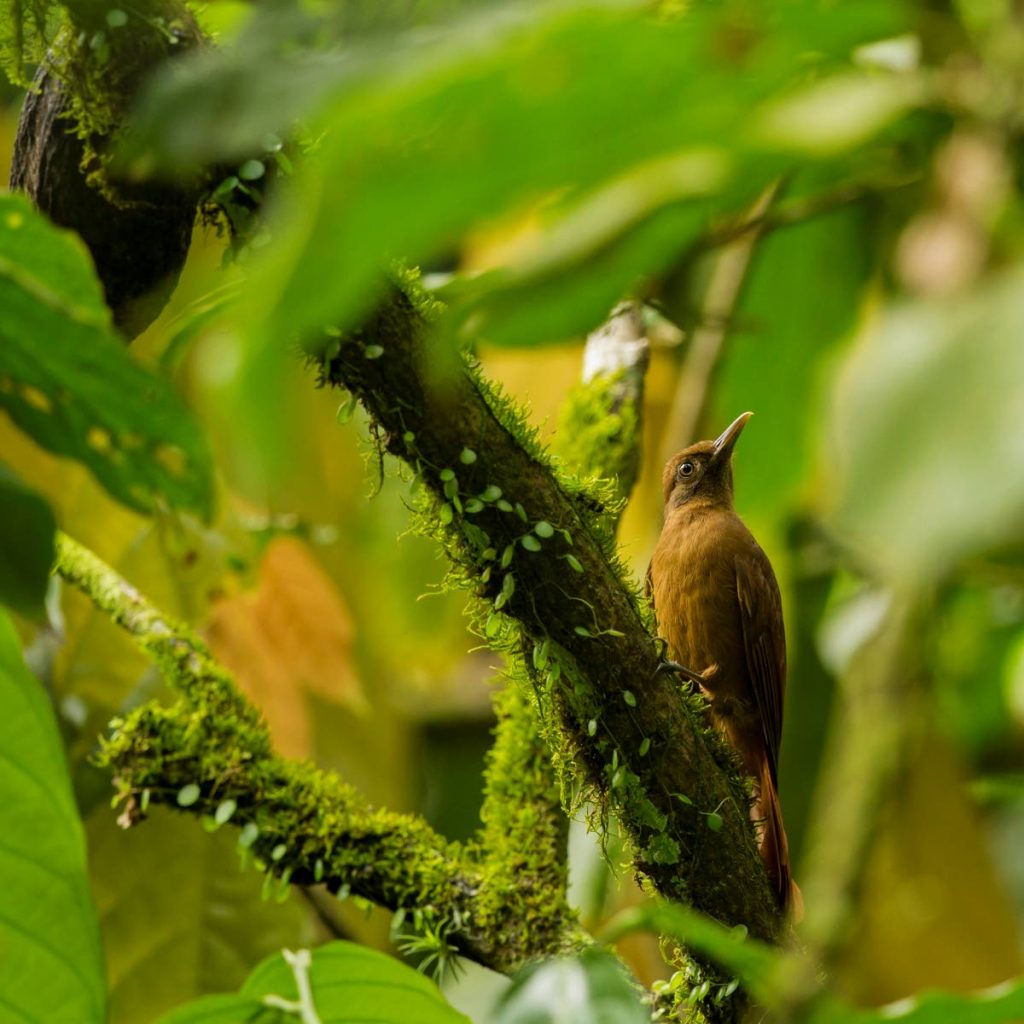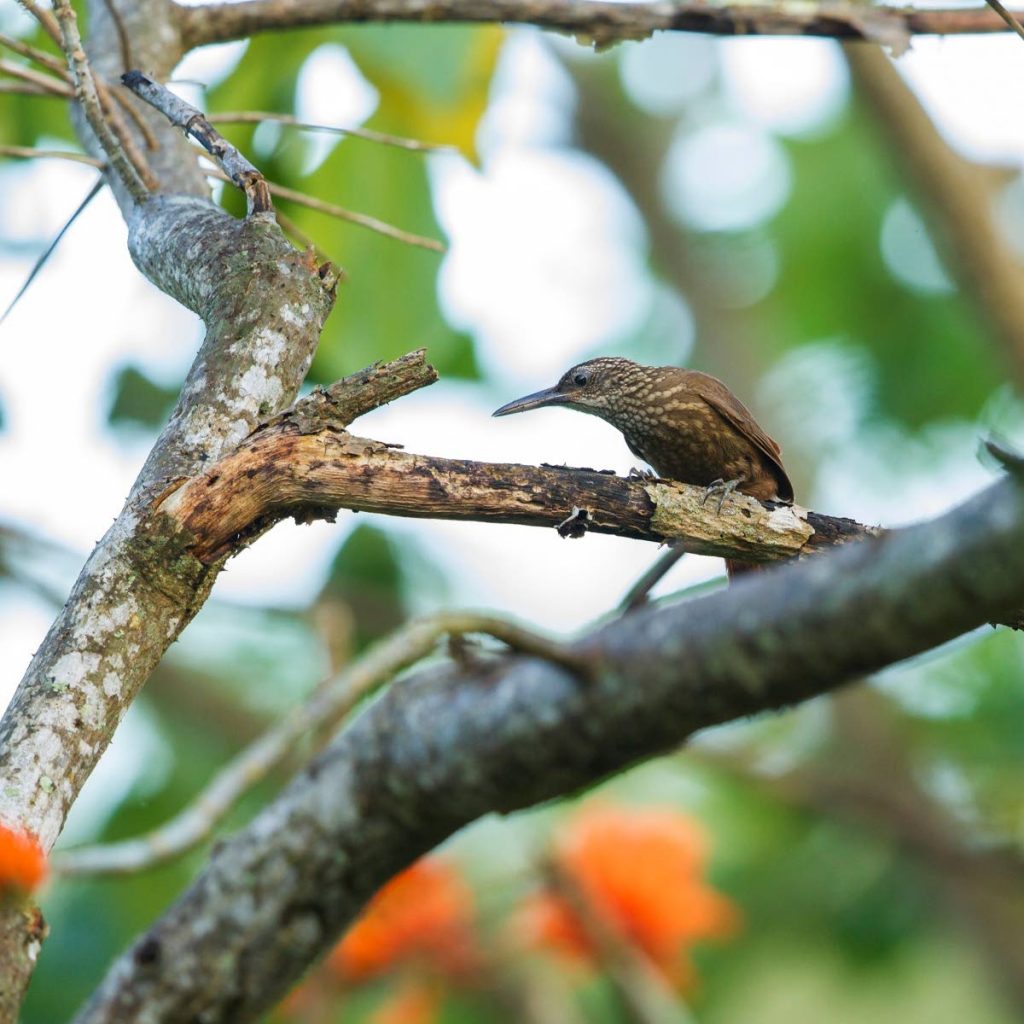Woodcreepers of Tobago

Faraaz Abdool
Birdwatchers regularly recall seeing woodpeckers but woodcreepers are quite different and unfamiliar to many. One is often unsure of whether or not the flash of brown is a bird – until it takes to the air, flapping and gliding on splayed russet feathers to assume a position on the side of another tree.
As their name suggests, woodcreepers do seem to creep effortlessly up and down the trunks of trees, defying gravity as they hop along the underside of branches. Just as woodpeckers are tethered to large trees, so too are woodcreepers. Being smaller birds, however, allows them access to thinner branches than their heavier cousins; and thus they have the luxury of foraging further away from the thickest limbs. Most woodcreepers are designed to blend into the barks of trees they frequent. In fact, they appear to have a wooden finish.
A good look is necessary in order to confidently identify a particular species, as they differ on particular and delicate details. Some have milky spots among their brown feathers, others have stripes. A few species have no spots or stripes at all. TT hosts five species, three of which are found on Tobago.
The largest of the three – and also the largest woodcreeper on both islands – is the ubiquitous cocoa woodcreeper. With light coloured spots on its head and a beautiful scalloped pattern on its throat and breast, its striking appearance is only surpassed by its rich voice. Far-carrying and musical, varying between a thick “kew” and an extended, plaintive wailing, the call of the cocoa woodcreeper permeates the soundscape of Tobago’s forests from Arnos Vale to Speyside. Equal doses of care and patience are required to locate a vocalising cocoa woodcreeper, for even though its call is exceedingly loud, often it would be calling from a frustratingly short distance away – from the far side of a tree trunk.

The most distinguishing characteristic of the cocoa woodcreeper is not its chocolate tinged nape, nor its milky white chin – but its massive, thick black bill. Looking almost disproportionate to the size of the bird, it’s used to pry dying segments of bark off of the limbs of trees to access the tasty invertebrates hiding beneath.
Tobago is also home to the smallest of the five woodcreepers found in TT. The olivaceous woodcreeper is as fancy as its name implies; it looks like a regular woodcreeper that fell halfway into a vat of olive-grey paint, head first. This colouration combined with its small size makes it resemble a rodent scurrying up a tree trunk. Not only is it smaller in stature than the cocoa woodcreeper, but its bill is also much more delicate – it hunts crevices in tree trunks for small insects and spiders.
Olivaceous woodcreepers tend to stick to the lower parts of trees, even though their diminutive stature would allow them to move along the thinnest of branches. These small woodcreepers hunt tree trunks from the roots up, ascending the tree while circumnavigating the trunk to catch any runners. Once they reach high enough, they would glide to the base of a nearby tree and pick their spiral path around its trunk.
Olivaceous woodcreepers are found throughout much of Central and South America, from Mexico in the north to Argentina in the south. They are also widespread in Venezuela and common in Tobago in most forested areas, especially within the Main Ridge Forest Reserve. Surprisingly, it is completely absent from Trinidad, making this the only species out of the five woodcreepers recorded in TT that is found only on Tobago.

- Faraaz Abdool
The third woodcreeper that inhabits Tobago is much less common than the other two. Plain-brown woodcreepers are as their name suggests, plain and brown. A close look at this bird would reveal subtle variations in plumage; it sports a greyish ring around its eyes that is only visible via an intimate experience. Plain-brown woodcreepers live in forested areas including those that have been cultivated for cocoa plantations, where they feed in a rather unique manner for a woodcreeper.
Plain-brown woodcreepers are consummate followers of swarms of army ants through the forest. They, oddly enough, have never been observed feeding on the ants. Their strategy is simple: army ants strike fear into all the other creatures of the undergrowth and leaf litter, creatures that generally remain invisible to the casual observer, human or avian. An approaching river of army ants makes countless beetles, cockroaches and other insects seek higher ground, sometimes on an overhanging twig or up the trunk of a nearby tree. This is precisely what the plain-brown woodcreeper plays for. Disturbed and distracted invertebrates make easy prey, and these crafty creepers make short work of army ant escapees – even spiders and centipedes are not safe.
The inner workings of the forest are a marvel to experience, and we can always learn something new by simply immersing oneself in nature, observing the daily to-ing and fro-ing of the participants in this eternal saga, the deft balance of life and death. At the very least it must put our own existence into perspective – to observe so many unrelated species exist harmoniously, co-operating for a common goal where one may or may not stand to personally benefit – it must strike some chord within. For in our own supposedly advanced society where we all belong to the same species, where we all superficially resemble one another – coexistence seems a concept that is unfortunately and detrimentally foreign.

Comments
"Woodcreepers of Tobago"